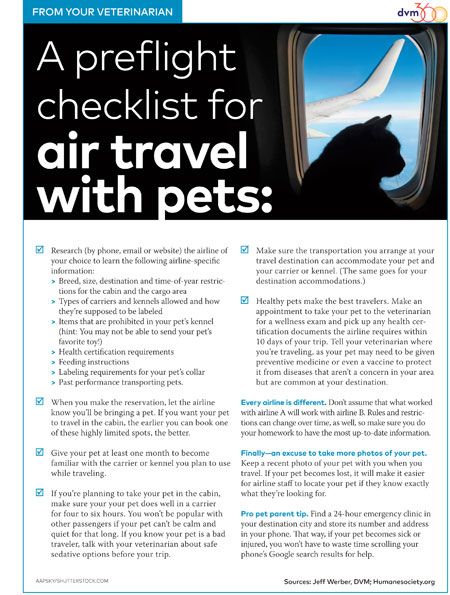Client handout: A preflight checklist for air travel with pets
The holidays are coming, which means questions and concerns about traveling with pets will be coming too.
According to the U.S. Department of Transportation, around 2 million live animals travel by air every year in the United States. The vast majority of these pets arrive at their destinations and back home again safe and sound. Yet things do go wrong (26 pets died while in the care of an airline in 2016, according to the U.S. Department of Transportation's Air Travel Consumer Reports), and when they do, it tends to make the national news and cause pet owners to panic.
An ‘Oh no!' story with a happy ending
Dr. Werber told dvm360 the following story to illustrate that human errors put pets in danger more often than plane errors:
One of my good friends was moving and needed to transport his magnificent golden retriever in the cargo hold. My friend was careful to tell everybody on the airline staff that they were traveling with a dog. When he boarded the plane, he could see his dog's crate sitting on the tarmac. The airline wanted to load all of the luggage first and put the dog in last so it could be the first one out.
At least that was the plan.
All of a sudden, my friend heard the big CLUMP! of the door closing and the pre-takeoff announcements begin. The engine started, and the plane began backing out … without the dog on board. The airline had forgotten to add the golden at the end! My friend caught it in time, but the moral of the story is that you're often dealing with human error more than plane error.
As to whether this worry is warranted, Jeff Werber, DVM, says probably not-at least for healthy pets. He likens the anxiety to people being more afraid of flying than of driving, even though far more people die in car crashes than plane crashes.
“According to the airlines, cargo areas carrying pets are controlled for temperature and pressure. When there is a problem, it's often related to other factors, such as stress, anxiety, breed-specific health problems and human error,” says Dr. Werber.
In the age of social media and online reviews, and at a time when pets are becoming more and more like family members, airlines and airports are wisely stepping up their game to be more pet-friendly, Dr. Werber says. This means that it may become increasingly common for veterinarians to step in and help clients evaluate whether traveling with pets by plane is worth the headache.
Why travel etiquette matters
Dr. Werber is full of great stories. Here's another:
A client of mine who took her dog in the cabin with her cheated and took the dog out of the carrier midflight to put him on her lap. She covered him with a blanket and proceeded to fall asleep. Later on, my client was elbowed awake by the passenger next to her: “Excuse me, ma'am. Your dog just pooped in the aisle.”
“With the availability of such amazing boarding facilities, I tell clients that they really need to evaluate if it's worth all of the trouble and the angst-for the pets and themselves-to take a pet on a short trip, says Dr. Werber.
If your clients decide that it is, in fact, worth all of the trouble and angst, provide them with this handout of tips for preparing both the pets and the clients for air travel.

Click on the handout to download a printable copy.